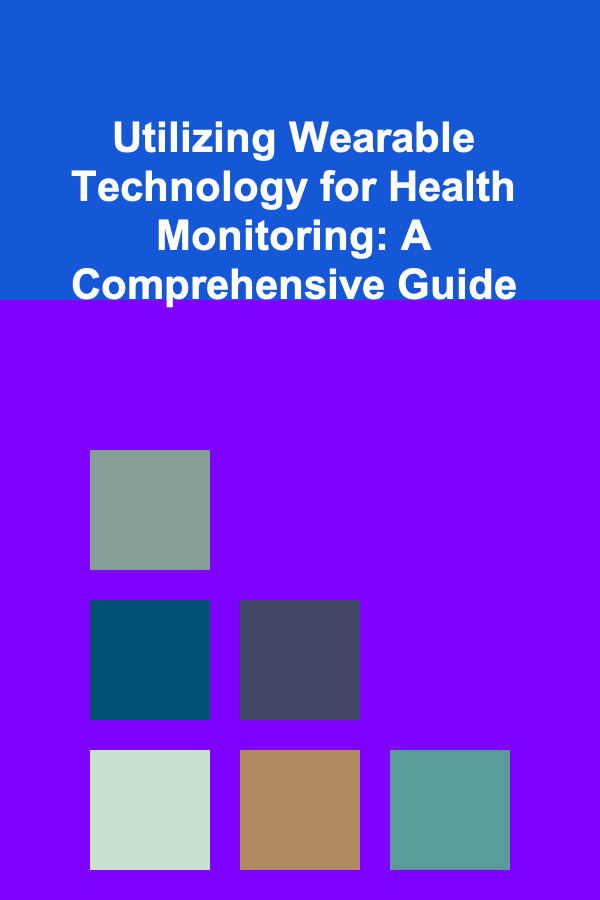
Utilizing Wearable Technology for Health Monitoring: A Comprehensive Guide
ebook include PDF & Audio bundle (Micro Guide)
$12.99$9.99
Limited Time Offer! Order within the next:

Wearable technology has revolutionized the way we understand and manage our health. From simple fitness trackers to sophisticated medical-grade devices, these gadgets offer unprecedented opportunities for continuous, personalized health monitoring. This comprehensive guide explores the various applications of wearable technology in healthcare, delving into the types of devices available, the data they collect, the benefits they offer, the challenges they present, and the ethical considerations surrounding their use.
I. Introduction to Wearable Technology in Healthcare
Wearable technology refers to electronic devices that can be worn on the body, either as accessories or embedded in clothing. Their primary function in healthcare is to collect physiological data, analyze it, and provide users and healthcare professionals with insights into an individual's health status. This real-time data collection allows for proactive health management, early detection of potential health issues, and personalized treatment plans.
The evolution of wearable technology has been rapid. Early devices focused primarily on activity tracking, but advancements in sensor technology, data processing, and wireless communication have led to more sophisticated devices capable of monitoring a wider range of physiological parameters. This evolution has been fueled by increased consumer awareness of health and wellness, as well as the growing prevalence of chronic diseases that require continuous monitoring.
II. Types of Wearable Devices for Health Monitoring
The market for wearable health monitoring devices is diverse, offering a range of products tailored to different needs and functionalities. Here's an overview of some of the most common types:
A. Fitness Trackers and Smartwatches
Fitness trackers and smartwatches are arguably the most popular types of wearable devices. They typically incorporate sensors to monitor:
- Activity levels: Steps taken, distance traveled, calories burned, and active minutes.
- Heart rate: Continuous heart rate monitoring, resting heart rate, and heart rate variability (HRV).
- Sleep patterns: Sleep duration, sleep stages (light, deep, REM), and sleep disturbances.
- GPS tracking: Location and route mapping during outdoor activities.
These devices are often used for general wellness monitoring, exercise tracking, and motivation to adopt healthier lifestyles. Many smartwatches also offer smartphone integration, allowing users to receive notifications, make calls, and control other devices.
B. Continuous Glucose Monitors (CGMs)
CGMs are specifically designed for individuals with diabetes. They continuously monitor glucose levels in interstitial fluid, providing real-time data and alerts for hyperglycemia (high blood sugar) and hypoglycemia (low blood sugar). This allows individuals to manage their diabetes more effectively by adjusting insulin dosages, diet, and exercise.
Modern CGMs often integrate with insulin pumps to create closed-loop systems, also known as artificial pancreas systems. These systems automatically adjust insulin delivery based on glucose levels, minimizing the need for manual intervention.
C. Electrocardiogram (ECG) Monitors
Wearable ECG monitors, such as smartwatches with ECG functionality and dedicated ECG patches, can record the electrical activity of the heart. This allows for the detection of arrhythmias, such as atrial fibrillation (AFib), a common heart condition that can increase the risk of stroke. These devices can be used for episodic recording (taking a reading when experiencing symptoms) or continuous monitoring.
Data from wearable ECG monitors can be shared with healthcare professionals for diagnosis and treatment planning. The FDA has approved several wearable ECG devices for medical use.
D. Blood Pressure Monitors
Wearable blood pressure monitors offer a convenient way to track blood pressure levels throughout the day. These devices typically use inflatable cuffs or sensor-based technology to measure systolic and diastolic blood pressure. Continuous blood pressure monitoring can help individuals and healthcare professionals identify patterns and trends that may not be apparent with infrequent clinic visits.
However, it's crucial to note that the accuracy of wearable blood pressure monitors can vary, and it's important to use devices that have been clinically validated.
E. Oxygen Saturation Monitors (Pulse Oximeters)
Pulse oximeters measure the oxygen saturation level in the blood (SpO2), which is the percentage of hemoglobin in the red blood cells that is carrying oxygen. Wearable pulse oximeters are often used by individuals with respiratory conditions, such as asthma and COPD, to monitor their oxygen levels and detect desaturation (low oxygen levels). They are also used during sleep studies to detect sleep apnea.
The accuracy of pulse oximeters can be affected by factors such as skin pigmentation, peripheral perfusion, and motion. It's important to use devices properly and consult with a healthcare professional for interpretation of the results.
F. Neurological Monitoring Devices
Wearable neurological monitoring devices are used to track brain activity, muscle activity, and other neurological parameters. These devices include:
- Electroencephalography (EEG) headsets: Measure brainwave activity for research, neurofeedback, and monitoring neurological conditions like epilepsy.
- Electromyography (EMG) sensors: Measure muscle activity for rehabilitation, sports performance, and detecting muscle disorders.
- Accelerometers and gyroscopes: Detect tremors and monitor movement disorders like Parkinson's disease.
These devices are typically used in clinical settings and research studies, but increasingly, consumer-grade devices are becoming available for personal use.
G. Other Emerging Wearable Technologies
The field of wearable technology is constantly evolving, with new devices and applications emerging regularly. Some other emerging technologies include:
- Sweat sensors: Measure biomarkers in sweat, such as electrolytes, glucose, and cortisol, providing insights into hydration levels, metabolic status, and stress levels.
- UV sensors: Measure exposure to ultraviolet (UV) radiation from the sun, helping users to protect themselves from sunburn and skin cancer.
- Posture monitors: Detect and correct poor posture, reducing the risk of back pain and other musculoskeletal problems.
- Fall detection sensors: Detect falls and automatically alert emergency services, particularly useful for elderly individuals.
III. Data Collection and Analysis
The core functionality of wearable health monitoring devices lies in their ability to collect and analyze physiological data. This process involves several key steps:
A. Sensor Technology
Wearable devices rely on a variety of sensors to collect data. These sensors include:
- Accelerometers: Measure acceleration and detect movement.
- Gyroscopes: Measure angular velocity and orientation.
- Photoplethysmography (PPG) sensors: Use light to measure blood flow and heart rate.
- Electrodes: Measure electrical activity, such as ECG and EMG.
- Chemical sensors: Measure the concentration of specific substances, such as glucose and electrolytes.
The accuracy and reliability of these sensors are crucial for the validity of the data collected. Manufacturers are constantly working to improve sensor technology and minimize errors.
B. Data Processing and Algorithms
The raw data collected by sensors is often noisy and requires processing to extract meaningful information. Algorithms are used to filter out noise, identify patterns, and calculate relevant metrics, such as heart rate variability, sleep stages, and activity intensity. The accuracy of these algorithms directly impacts the usefulness of the data.
Machine learning techniques are increasingly being used to improve the accuracy and personalization of data analysis. These techniques can learn from individual user data to provide more accurate predictions and personalized recommendations.
C. Data Storage and Transmission
Data collected by wearable devices is typically stored on the device itself or transmitted to a smartphone, computer, or cloud-based platform. Wireless communication technologies, such as Bluetooth and Wi-Fi, are used for data transmission. Cloud storage allows for long-term data archiving and access from multiple devices. Data security and privacy are paramount, requiring robust encryption and access control measures.
D. Data Visualization and Reporting
The processed data is typically presented to users through mobile apps, web dashboards, or reports. Data visualization tools, such as charts and graphs, are used to make the data easier to understand and interpret. Reports may include summaries of key metrics, trends over time, and personalized insights. Effective visualization and reporting are critical for empowering users to make informed decisions about their health.
IV. Benefits of Wearable Technology for Health Monitoring
Wearable technology offers a wide range of benefits for individuals, healthcare providers, and the healthcare system as a whole:
A. Improved Health Awareness and Motivation
Wearable devices can increase awareness of health behaviors and promote healthy habits. By tracking activity levels, sleep patterns, and other metrics, users become more conscious of their lifestyle choices and are motivated to make positive changes. Gamification features, such as badges and challenges, can further enhance motivation.
B. Early Detection of Health Issues
Continuous monitoring of physiological data can help detect subtle changes that may indicate the onset of a health problem. For example, a wearable ECG monitor can detect atrial fibrillation before it causes a stroke. Early detection allows for timely intervention and improved health outcomes.
C. Personalized Treatment Plans
Wearable devices can provide healthcare providers with valuable data to personalize treatment plans. By tracking a patient's response to medication, lifestyle changes, or therapy, providers can adjust treatment strategies to optimize effectiveness. This personalized approach can lead to better outcomes and improved patient satisfaction.
D. Remote Patient Monitoring
Wearable technology enables remote patient monitoring, allowing healthcare providers to track patients' health status from a distance. This is particularly beneficial for individuals with chronic conditions, elderly individuals, and those living in remote areas. Remote monitoring can reduce the need for frequent clinic visits and hospitalizations, improving access to care and reducing healthcare costs.
E. Enhanced Research and Data Collection
Wearable devices generate vast amounts of data that can be used for research purposes. This data can be used to study disease patterns, evaluate the effectiveness of interventions, and develop new treatments. Wearable technology can also facilitate large-scale clinical trials by allowing for continuous data collection in real-world settings.
F. Improved Adherence to Treatment
Wearable technology can improve adherence to treatment plans by providing reminders, tracking progress, and offering personalized support. For instance, medication adherence trackers can remind patients to take their medications on time, while activity trackers can encourage patients to engage in regular exercise. Improved adherence leads to better health outcomes and reduced healthcare costs.
V. Challenges and Limitations of Wearable Technology
Despite the numerous benefits of wearable technology, there are also several challenges and limitations that need to be addressed:
A. Accuracy and Reliability
The accuracy of wearable devices can vary depending on the device, the sensor technology used, and the individual user. Factors such as skin pigmentation, body composition, and environmental conditions can affect sensor performance. It's important to choose devices that have been clinically validated and to use them properly to ensure accurate data collection.
B. Data Security and Privacy
Wearable devices collect sensitive personal health information, raising concerns about data security and privacy. Data breaches and unauthorized access can compromise the privacy of users. It's crucial to implement robust security measures, such as encryption and access control, to protect data from unauthorized access.
C. Data Overload and Interpretation
Wearable devices generate a large volume of data, which can be overwhelming for users and healthcare providers. Effective data visualization and reporting are essential to make the data easier to understand and interpret. Healthcare providers need to be trained on how to use wearable data effectively to inform clinical decision-making.
D. Regulatory Issues
The regulatory landscape for wearable health monitoring devices is still evolving. The FDA has issued guidance on the regulation of medical devices, but there is still uncertainty about the regulatory status of many consumer-grade devices. Clearer regulations are needed to ensure the safety and effectiveness of wearable devices.
E. Cost and Accessibility
The cost of wearable devices can be a barrier to access for some individuals. While some affordable devices are available, more sophisticated medical-grade devices can be expensive. Efforts are needed to make wearable technology more accessible to all populations, regardless of their socioeconomic status.
F. Integration with Existing Healthcare Systems
Integrating wearable data into existing healthcare systems can be challenging. Electronic health record (EHR) systems are not always designed to accommodate data from wearable devices. Standardized data formats and interoperability standards are needed to facilitate the seamless integration of wearable data into healthcare workflows.
G. User Adoption and Compliance
Even with accurate and insightful data, user adoption and compliance remain significant hurdles. Many users abandon wearable devices after a short period of time. Factors influencing abandonment include discomfort, lack of motivation, and difficulty interpreting the data. Improving device design, user experience, and providing ongoing support can help increase user adoption and compliance.
VI. Ethical Considerations
The use of wearable technology for health monitoring raises several ethical considerations that need to be addressed:
A. Privacy and Confidentiality
Protecting the privacy and confidentiality of personal health information is paramount. Users need to be informed about how their data will be collected, used, and shared. Consent should be obtained before collecting and sharing data. Data should be anonymized whenever possible to protect the identity of users.
B. Data Security
Ensuring the security of data is essential to prevent unauthorized access and misuse. Robust security measures, such as encryption and access control, should be implemented to protect data from breaches. Users should be informed about the security measures in place and their rights regarding their data.
C. Bias and Fairness
Wearable devices and algorithms may exhibit bias, leading to unfair or inaccurate results for certain populations. For example, some heart rate sensors may be less accurate on individuals with darker skin pigmentation. It's important to address bias in algorithms and ensure that wearable technology is fair and equitable for all users.
D. Informed Consent
Users need to provide informed consent before using wearable devices for health monitoring. They should be informed about the risks and benefits of using the device, how their data will be used, and their rights regarding their data. Consent should be voluntary and freely given.
E. Data Ownership and Control
Users should have ownership and control over their data. They should have the right to access, modify, and delete their data. They should also have the right to choose who their data is shared with.
F. Responsibility and Liability
It's important to clarify the responsibilities and liabilities of manufacturers, healthcare providers, and users regarding the use of wearable technology. Manufacturers should be responsible for the safety and effectiveness of their devices. Healthcare providers should be responsible for interpreting the data and providing appropriate medical advice. Users should be responsible for using the device properly and following medical advice.
VII. Future Trends in Wearable Health Monitoring
The future of wearable health monitoring is promising, with several exciting trends on the horizon:
A. Miniaturization and Integration
Wearable devices are becoming smaller, more comfortable, and more integrated into clothing and accessories. This trend will make wearable technology more discreet and easier to use.
B. Advanced Sensor Technology
New sensor technologies are being developed to measure a wider range of physiological parameters, such as biomarkers in sweat, tears, and saliva. These sensors will provide more comprehensive and personalized health information.
C. Artificial Intelligence and Machine Learning
AI and machine learning are being used to improve the accuracy, personalization, and predictive capabilities of wearable devices. These technologies will enable more sophisticated data analysis and personalized recommendations.
D. Virtual and Augmented Reality
Virtual and augmented reality are being integrated with wearable technology to create immersive health and wellness experiences. For example, VR can be used to provide guided meditation and relaxation exercises, while AR can be used to overlay health information onto the user's field of view.
E. Personalized Medicine
Wearable technology is playing an increasingly important role in personalized medicine. By providing continuous and personalized health data, wearable devices can help tailor treatment plans to individual needs and improve health outcomes.
F. The Internet of Medical Things (IoMT)
Wearable devices are becoming part of the Internet of Medical Things (IoMT), a network of interconnected medical devices and systems. The IoMT will enable seamless data sharing and collaboration between healthcare providers, researchers, and patients.
VIII. Conclusion
Wearable technology has the potential to transform healthcare by empowering individuals to take control of their health, enabling early detection of health issues, and facilitating personalized treatment plans. However, it's important to address the challenges and limitations of wearable technology, such as accuracy, data security, and ethical considerations, to ensure that these devices are used safely and effectively. As technology continues to advance, wearable devices will play an increasingly important role in promoting health and well-being.

How to Deal with Critters in Your Tent
Read More
How to Identify and Get Rid of Unused Inventory Items
Read More
How to Organize Essential Oils for Skin Care and Beauty
Read More
How to Organize Your Wardrobe with Limited Closet Space
Read More
How to Pack Fragile Items Safely for Moving
Read More
How to Reduce Inflammation for Faster Fat Loss
Read MoreOther Products

How to Deal with Critters in Your Tent
Read More
How to Identify and Get Rid of Unused Inventory Items
Read More
How to Organize Essential Oils for Skin Care and Beauty
Read More
How to Organize Your Wardrobe with Limited Closet Space
Read More
How to Pack Fragile Items Safely for Moving
Read More